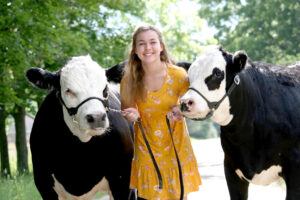By David Fleet
Editor
Brandon Twp.-Bonnie and Clyde were very profitable for a local youth.
Allie Bottiglia, 15, along with sisters Taylor, 19, and Tara, 17, are members of the 4H Livestock Club and recently participated in the Oakland County Fair and Livestock auction last month in Davisburg. Allie’s pair of Angus-Hereford cross were sold at the auction with Bonnie at 1,030 pounds selling for $3.20 per pound. Clyde tipped the scales at 1,205 pounds grossing $3.60 per pound for Bottiglia.
Allie started showing calves at just 5-years-old, and the 2021 Fair was the first year for full grown cattle.
“Bonnie and her brother Clyde are grain and grass fed,” said Allie who purchased the pair of 200 pound, three-month-old calves in August 2020.
“They are local beef and our buyers will know what they are getting. Meat prices are sky high right now, so whoever buys from us will get the very best for their money. We are already picking out calves for the 2022 Oakland County Fair.”
Bottiglias’s home grown cattle enters the local market in a post-pandemic economy where availability and cost of many products, like beef are still fluctuating.
For example, according to the Consumer Price Index between May and June of 2021 uncooked beef and veal up 6.4 percent; beef steaks up 6 percent and pork, including roasts, steaks and ribs, up 5 percent.
For small agricultural businesses like the Bottiglia’s quality is key but the regional food processing drives up the cost to where many local products just can’t compete with big business.
Trey Malone is a assistant professor and Extension Economist at Michigan State University.
“The idea of regional food processing has been around for a long time,” said Malone, during an interview with The Citizen last week. “It’s more an issue of scale, where currently the size of the processors in Michigan are very large and dominate the markets.”
Malone said that it would take building 100 small processing systems to replace just one of the very large plants operating today.
“The large processing plants have the money for upgrades and efficiency that will reduce costs in production,” he said.
Washington has taken notice.
As part of an executive order signed by President Joe Biden, Agriculture Sec. Tom Vilsack recently announced a $500 million investment to expand capacity and increase competition in meat and poultry processing. Additionally, The Department of Agriculture (USDA) will provide $150 million to help small processing facilities weather the pandemic, compete in the marketplace, and reach more customers. This will include supporting value-added markets and local and regional food distribution systems.
“While the pandemic exposed the vulnerability of our food system, the lack of competition in the marketplace has long been an issue,” said Vilsack in a statement. “By providing grants, loans and technical assistance to smaller facilities, the USDA can address concentration within the industry and create competitive options so that farmers, ranchers, and consumers have access to better choices and fairer prices.”
Malone added the local aspect is important.
“The community agricultural component is vital,” he said. “It’s important to know how animals are raised and the community aspect of 4-H to bring people together is also part of the equation. Right now less than 1 percent of Americans are involved in agriculture. The quality of products, like those offered by local farms really can make a difference.”
